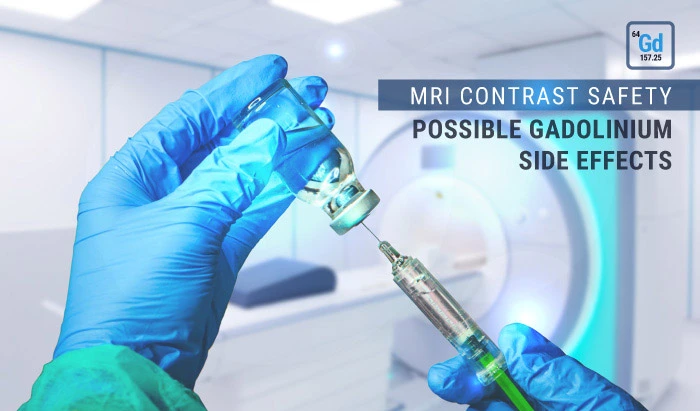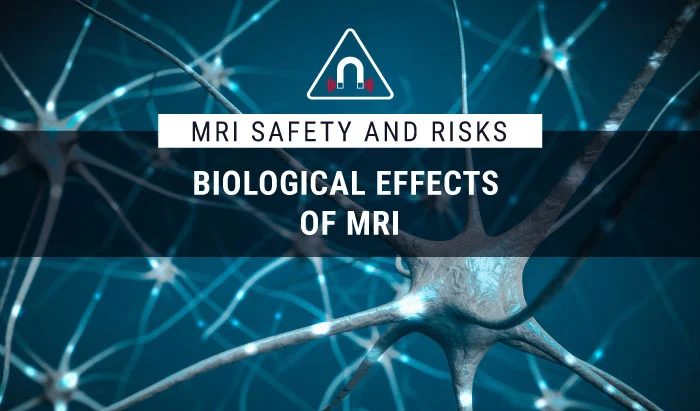MRI Contrast Safety: Possible Gadolinium Side Effects

MRI Contrast Safety: Possible Gadolinium Side Effects


This article is part of our series of articles on MRI safety for MRI technologists. (Check out our article on the biological effects of MRI here!). This article is focused on MRI contrast media safety, specifically on the possible side effects of gadolinium, preventative measures that you as an MRI technologist can take, and what to do if your patient does experience a side effect after the administration of gadolinium.
MRI Contrast Safety: Overview
Contrast media—gadolinium for MRI—is given to patients in approximately 1 out of every 3 examinations. Most often, it is in the form of an IV injection of a paramagnetic pharmaceutical agent which alters the T1 relaxation of some tissues in order to improve the contrast.
![]()
In a healthy person, the contrast agent will be eliminated by the kidneys. However, in recent years, it has been realized that patients whose kidneys are not functioning properly are at risk for a condition called nephron-systemic fibrosis (NSF). And, because contrast material is most often given as an injection, risks associated with intravenous access, such as extravasation, phlebitis, and infection, must also be taken into consideration. In addition to the risks already mentioned, some patients have hypersensitivity or allergic reactions to these contrasts.
Though these side effects or reactions are not frequent occurrences, it is crucial for an MRI technologist to be able to identify the possible side effects, their symptoms, and the procedures to follow to ensure patient safety.
MRI Contrast Safety: Extravasation
Extravasation is the escape of fluid from a vessel into the surrounding cutaneous tissues. It occurs in less than 1% of all injections, and more commonly when pressure injectors are utilized. Patients who have weak vessels are at much greater risk of extravasation.
Most of the time, extravasations do not pose much of a problem. The technologist will stop the injection the moment the patient experiences symptoms of extravasation. These symptoms include swelling, pain, and redness at the injection site. These can be treated easily by alternately applying warm and cold compresses to the site. This helps the contrast to be absorbed into the tissue.
![]()
In very rare cases, more severe complications occur, such as blistering of the skin, sloughing of the skin, and scarring requiring a skin graft. Well-tolerated in general, an extravasation can be painful and disrupt the examination process. Patients should be informed that this is a potential, albeit rare, side effect of the gadolinium injection required for the examination.
What to do if extravasation occurs
If an extravasation is noted, stop the injection immediately. The next step is to determine how much contrast extravasated and document the amount. If possible, try to extract or aspirate the product (this is not often possible). The affected arm should be elevated. Then the cold/warm compresses should be applied. The cold compress should be applied for 20 minutes, then the warm compress for 20 minutes.
Be sure to explain to the patient what happened and provide follow-up instructions for care. All cases should be documented in the patient’s chart and reported to their physician.
At a later time, a search for signs of weak vascular and neurological tolerance. A medical control should be provided for 24 hours. Most cases will involve a small amount of contrast, as contrast is injected in small amounts in MRI. Because of the small volume, the contrast will reabsorb easily.
Hypersensitivity Reactions/Responses
Hypersensitivities are divided into two classifications: Allergic hypersensitivity and non-allergic hypersensitivity. The most basic difference is: allergic hypersensitivity involves histamines being produced by the body, and non-allergic hypersensitivity does not.
Allergic reactions can occur immediately, in less than an hour (serious reaction), or later, up to 7 days later. Non-allergic responses are toxic effects and pharmacological effects that can also occur immediately or later.
These reactions are characterized by the organ system affected. On the chart below, we can see the different organ systems which may be possibly affected by contrast injections in MRI. Note that this chart includes both allergy symptoms and non-allergy symptoms. All adverse situations are different.
| Organ System | Symptoms |
| General | headache, chest pain, fever, fatigue, arthralgia, hot flash, flushing, weakness, watery eyes, general “strange sensation” |
| Cardiovascular | hypotension, hypertension, vasodilation, ECG changes, chest pain, phlebitis, bradycardia, tachycardia and A-V nodal rhythm |
| Gastrointestinal | nausea, vomiting, gastrointestinal stress or pain, increased salivation, diarrhea, itching or edema of the tongue, dry mouth |
| Neurological | include headache, paresthesia, tremor, ataxia, dizziness, tinnitus, seizures and syncope |
| Respiratory | throat irritation, dyspnea, wheezing, cough rash, itching, urticaria, erythema, sweating, swelling and tingling sensations |
| Dermatologic | rash, itching, urticaria, erythema, sweating, swelling and tingling sensations |
| Anaphylactoid | hives, itching, swelling of the airway, and shock |
The most common symptoms of hypersensitivities are:
Urticaria
![]()
Urticaria is itching of the skin due to redness or hives. If confined to the skin, it is more bothersome than dangerous. However, it can become more dangerous if it extends to the eyes, mouth, and larynx. It is important to be concerned if the patient expresses a feeling of itching in the mouth and/or throat.
Please note: patients do not have to show symptoms on the skin. The effect can occur in the mucosa tissues in the mouth and throat with no visible symptoms on the skin.
Quincke’s Edema
![]()
Quincke’s edema or edema of the uvula is classified as an angioneurotic edema. This is an immediate reaction, occurring a few minutes after taking a medication. It can be visually shocking, as some parts of the face (eyelids, throat, cheeks and/or lips) can start swelling quickly. Quincke’s edema can cause asphyxia due to an oropharyngeal attack and shock resulting from the anaphylaxis. The treatment should be immediate and requires a prescription of adrenaline and corticosteroids.
This can be very serious, because the edema in this area can make it difficult or even impossible for the patient to breath. Complaints of swelling of the face, tongue, lips or eyes, should be taken very seriously.
What to do if a hypersensitivity reaction occurs:
- Stop the injection
- Assess the seriousness of the reaction and monitor the patient
- Alert the radiologist
- Contact emergency responders if necessary
- Refer to case management or patient’s physician as needed
If a true reaction occurs, an explanation of what happened should be provided to the patient. The patient should be informed of the symptoms they experienced and what medication was administered, so they can notify medical staff of this reaction in the future.
Nephrogenic Systemic Fibrosis (NSF)
![]()
Nephrogenic Systemic Fibrosis (NSF) is another possible side effect of gadolinium. NSF occurs in patients who have kidneys that are not functioning efficiently. When gadolinium is in the bloodstream for longer than is recommended, it begins to deposit in the skin and joints. Symptoms of NSF include a fibrous feel to the skin, limited movement of joints, and muscle tissue that becomes striated.
The first case of NSF was documented in 1997. A link was quickly made between injections of IV contrast in MRI and renal impairment. This disorder can be very serious if it affects the muscles of the lungs, the diaphragm, and the heart.
Precautions to take regarding NSF:
- Identify patients at risk for NSF by evaluating the serum creatinine and GFR
- Follow manufacturer recommendations with regard to doses of contrast
- Consider another examination
- Discuss the risks and benefits of the injection of contrast if the patient would be at risk, or have the patient consult with the radiologist and/or ordering physician
Other Considerations for MRI Contrast Safety
There are two further risks associated with injections of gadolinium of which an MRI technologist should be aware.
The first relates to multiple MRI exams or MRI exams coupled with radiologic exams requiring iodinated contrast injections. As you may know, iodinated contrast can have an adverse effect on the functioning of the kidneys, reducing the efficiency of filtration. For this reason, MRI contrast safety examinations should be done BEFORE tests requiring an injection of iodinated contrast.
If a patient is having multiple MRI examinations requiring the injection of gadolinium, a minimum of 48 hours should separate the studies.
The second risk to bear in mind is the retention of contrast media in brain tissue. We will not discuss this risk as it is still being studied and requires further research.
Final Thoughts on MRI Contrast Safety
While very rare, the side effects resulting from the administration of gadolinium can be serious. The MRI technologist’s familiarity with these risks and how to manage them is critical for ensuring patient safety during examinations. Equally critical is the technologist’s skill in communicating with patients. Information Technology News reports that in recent years, patient concerns related to the safety of MRI contrast agents have risen, driven in large part by patient-created groups on social media and a high profile lawsuit filed by Chuck Norris against a contrast vendor for alleged adverse side effects of gadolinium suffered by his wife Gena. Allowing patients to voice their concerns and ask questions is important. And helping them to understand that the data to date shows that side effects are extremely rare, and that, properly administered, gadolinium is very safe can help reassure patients and enhance patient care.
Want to learn more about MRI Safety? Take our MRI Safety course.


